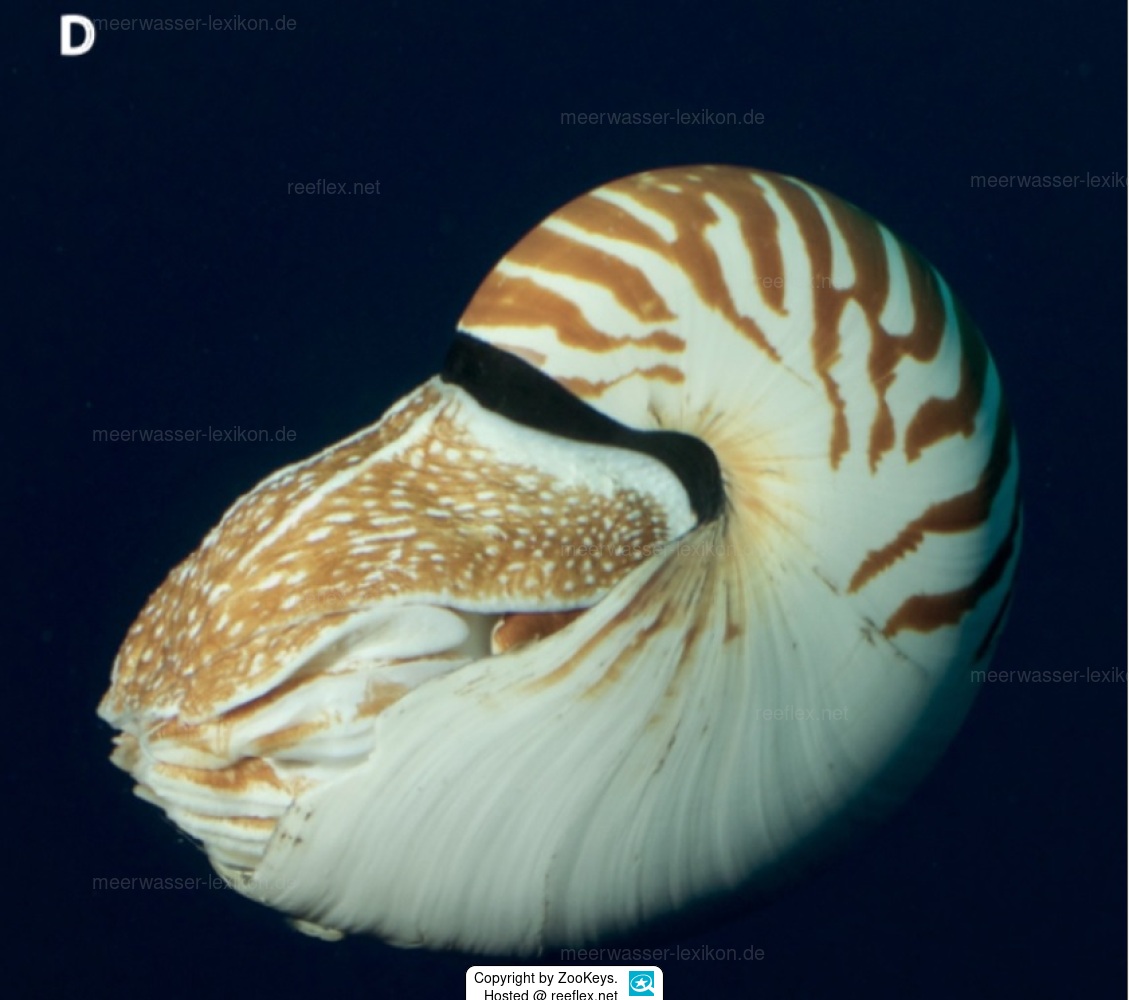Info
Nautilus vitiensis inhabits areas along the coast of Viti Levu, Fiji, near Suva Harbour and Pacific Harbour.
Specimens were collected and filmed on July 30, 2018 at depths between 200 - 400 m.
The following characteristics distinguish Nautilus vitiensis from other species of the genus Nautilus:
15-30% pigment coloration on the shell, more than in Nautilus pompilius, two color pattern morphs are present, both the full one (stripes from the abdomen to the umbilicus) and the "white umbilicus" variant, where the stripes flowing down from the abdomen end just before the umbilical region.
Shell coloration consists of simple stripes beginning at the belly and then extending down the side of the shell; these are large and unbranched and are among the simplest of all Nautilus shell coloration patterns.
The largest specimens of the new species are smaller than the smallest adult Nautilus pompilius, and this species is generally smaller than the other two new species described here, but there is some overlap.
Brief Description:
Nautilicon, shell with umbilical plug, whorl higher than broad at maturity. Periostracum completely absent in mature and nearly mature specimens; shell surface ornamented with growth lines parallel to aperture shape; no cross-hatching or ornamentation perpendicular to growth lines; low rugae.
Hood morphology consists of low, elliptical, white projections barely projecting above hood surface, on either side of two long, raised, parallel, white stripes running centrally across hood from shell whorl to aperture.
White projections between stripes on entire central section.
Mean diameter of adult shell 149.3 mm.
Literature reference:
Barord GJ, Combosch DJ, Giribet G, Landman N, Lemer S, Veloso J, Ward PD (2023)
Three new species of Nautilus Linnaeus, 1758 (Mollusca, Cephalopoda) from the Coral Sea and South Pacific.
ZooKeys 1143: 51-69. https://doi.org/10.3897/zookeys.1143.84427
This is an open access article distributed under the terms of the Creative Commons Attribution License (CC BY 4.0), which permits unrestricted use, distribution, and reproduction in any medium, provided the original author and source are credited.
Specimens were collected and filmed on July 30, 2018 at depths between 200 - 400 m.
The following characteristics distinguish Nautilus vitiensis from other species of the genus Nautilus:
15-30% pigment coloration on the shell, more than in Nautilus pompilius, two color pattern morphs are present, both the full one (stripes from the abdomen to the umbilicus) and the "white umbilicus" variant, where the stripes flowing down from the abdomen end just before the umbilical region.
Shell coloration consists of simple stripes beginning at the belly and then extending down the side of the shell; these are large and unbranched and are among the simplest of all Nautilus shell coloration patterns.
The largest specimens of the new species are smaller than the smallest adult Nautilus pompilius, and this species is generally smaller than the other two new species described here, but there is some overlap.
Brief Description:
Nautilicon, shell with umbilical plug, whorl higher than broad at maturity. Periostracum completely absent in mature and nearly mature specimens; shell surface ornamented with growth lines parallel to aperture shape; no cross-hatching or ornamentation perpendicular to growth lines; low rugae.
Hood morphology consists of low, elliptical, white projections barely projecting above hood surface, on either side of two long, raised, parallel, white stripes running centrally across hood from shell whorl to aperture.
White projections between stripes on entire central section.
Mean diameter of adult shell 149.3 mm.
Literature reference:
Barord GJ, Combosch DJ, Giribet G, Landman N, Lemer S, Veloso J, Ward PD (2023)
Three new species of Nautilus Linnaeus, 1758 (Mollusca, Cephalopoda) from the Coral Sea and South Pacific.
ZooKeys 1143: 51-69. https://doi.org/10.3897/zookeys.1143.84427
This is an open access article distributed under the terms of the Creative Commons Attribution License (CC BY 4.0), which permits unrestricted use, distribution, and reproduction in any medium, provided the original author and source are credited.







 ZooKeys
ZooKeys








